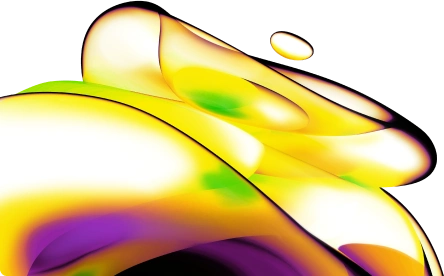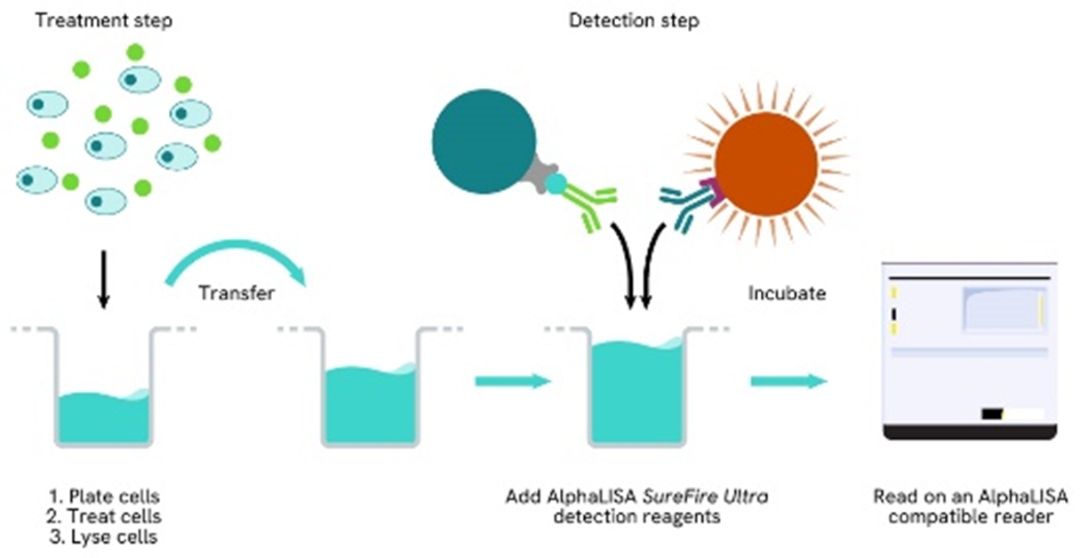

AlphaLISA SureFire Ultra Human and Mouse Total AKT1/2/3 Detection Kit, 500 Assay Points
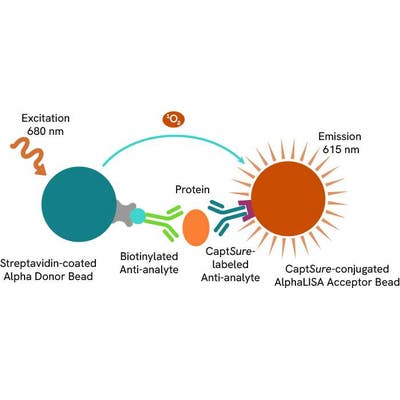

 View All
View All
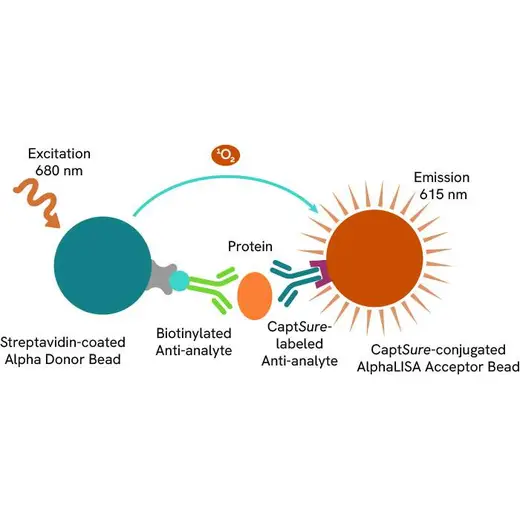




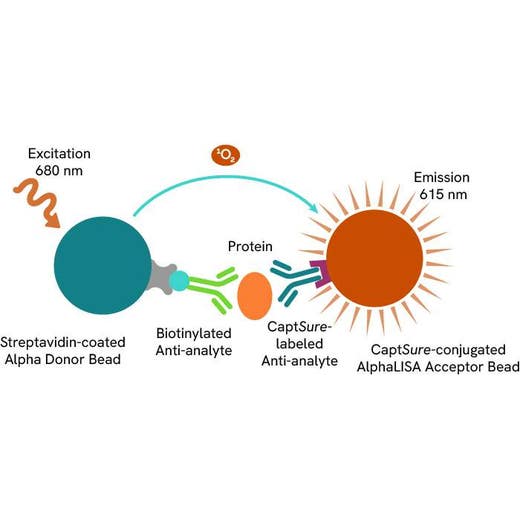




| Feature | Specification |
|---|---|
| Application | Cell Signaling |
| Sample Volume | 10 µL |















Product information
Overview
The AKT serine/threonine kinase, also known as protein kinase B (PKB), is a critical component of the PI3K/AKT/mTOR signaling pathway. In humans, there are three AKT isoforms (AKT1, AKT2, and AKT3) encoded by separate genes. AKT plays a central role in various cellular processes, including cell survival, proliferation, metabolism, and angiogenesis. While the activation state of AKT is often of interest, measuring total AKT levels is equally important for understanding the overall regulation and expression of this crucial signaling protein. AKT signaling is frequently dysregulated in various diseases, especially cancer, where alterations in AKT expression or activity can contribute to tumor growth, metastasis, and therapy resistance.
The AlphaLISA SureFire Ultra Human and Mouse Total AKT1/2/3 Detection Kit is a sandwich immunoassay designed for the quantitative detection of total AKT protein levels in cellular lysates, using Alpha technology.
Formats:
- The HV (high volume) kit contains reagents to run 100 wells in 96-well format, using a 60 μL reaction volume.
- The 500-point kit contains enough reagents to run 500 wells in 384-well format, using a 20 μL reaction volume.
- The 10,000-point kit contains enough reagents to run 10,000 wells in 384-well format, using a 20 μL reaction volume.
- The 50,000-point kit contains enough reagents to run 50,000 wells in 384-well format, using a 20 μL reaction volume.
AlphaLISA SureFire Ultra kits are compatible with:
- Cell and tissue lysates
- Antibody modulators
- Biotherapeutic antibodies
Alpha SureFire kits can be used for:
- Cellular kinase assays
- Receptor activation studies
- Screening
How it works
Total-AlphaLISA SureFire Ultra assay principle
The Total-AlphaLISA SureFire Ultra assay measures the expression level of a protein target in a cell lysate.
The Total-AlphaLISA SureFire Ultra assay uses two antibodies which recognize two different distal epitopes on the targeted protein. AlphaLISA assays require two bead types: Acceptor and Donor beads. Acceptor beads are coated with a proprietary CaptSure™ agent to specifically immobilize the assay specific antibody, labeled with a CaptSure tag. Donor beads are coated with streptavidin to capture one of the detection antibodies, which is biotinylated. In the presence of targeted protein, the two antibodies bring the Donor and Acceptor beads in close proximity whereby the singlet oxygen transfers energy to excite the Acceptor bead, allowing the generation of a luminescent Alpha signal. The amount of light emission is directly proportional to the quantity of protein present in the sample.
Total-AlphaLISA SureFire Ultra two-plate assay protocol
The two-plate protocol involves culturing and treating the cells in a 96-well plate before lysis, then transferring lysates into a 384-well OptiPlate™ plate before the addition of Total-AlphaLISA SureFire Ultra detection reagents. This protocol permits the cells viability and confluence to be monitored. In addition, lysates from a single well can be used to measure multiple targets.

Total-AlphaLISA SureFire Ultra one-plate assay protocol
Detection of Total target protein with AlphaLISA SureFire Ultra reagents can be performed in a single plate used for culturing, treatment, and lysis. No washing steps are required. This HTS designed protocol allows for miniaturization while maintaining AlphaLISA SureFire Ultra quality.
Assay validation
Validation of AKT1/2/3 in insulin treated cells
HeLa cells were seeded in a 96-well plate (20,000 cells/well) in complete medium, and incubated overnight at 37°C, 5% CO2. The cells were serum starved for 3 hours and then treated with increasing concentrations of Insulin for 5 minutes.
After treatment, the cells were lysed with 100 µL of lysis buffer for 10 minutes at RT with shaking (350 rpm). AKT1/2/3 Phospho (Ser473) and Total levels were evaluated using respective AlphaLISA SureFire Ultra assays. For the detection step, 10 µL of cell lysate (approximately 2,000 cells) was transferred into a 384-well white OptiPlate, followed by 5 µL of Acceptor mix and incubated for 1 hour at RT. Finally, 5 µL of Donor mix was then added to each well and incubated for 1 hour at RT in the dark. The plate was read on an Envision using standard AlphaLISA settings.
As expected, Insulin triggered an increase in the levels of Phospho (Ser473) AKT1/2/3 while Total levels remained unchanged.
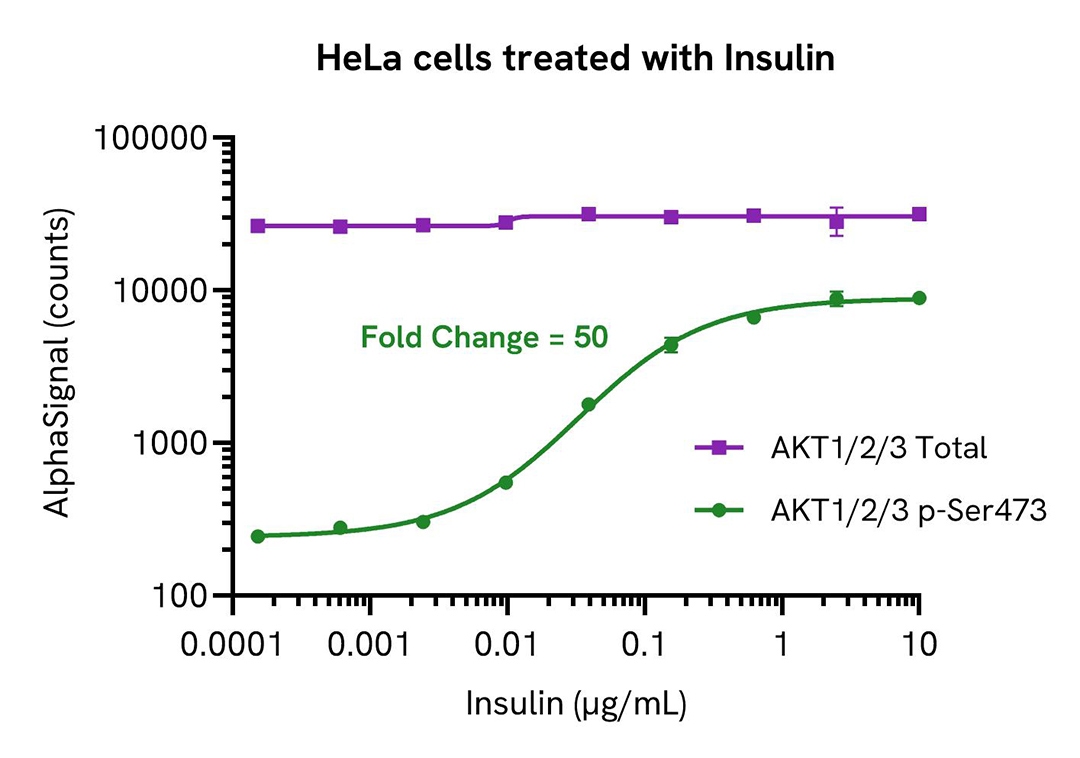
Validation of AKT1/2/3 in Razuprotafib treated cells
HUVEC cells were seeded in a 96-well plate (20,000 cells/well) in complete medium, and incubated overnight at 37°C, 5% CO2. The cells were serum starved for 2 hours and then treated with increasing concentrations of Razuprotafib for 15 minutes.
After treatment, the cells were lysed with 100 µL of Lysis Buffer for 10 minutes at RT with shaking (350 rpm). AKT1/2/3 Phospho (Ser473) and Total levels were evaluated using respective AlphaLISA SureFire Ultra assays. For the detection step, 10 µL of cell lysate (approximately 2,000 cells) was transferred into a 384-well white OptiPlate, followed by 5 µL of Acceptor mix and incubated for 1 hour at RT. Finally, 5 µL of Donor mix was then added to each well and incubated for 1 hour at RT in the dark. The plate was read on an Envision using standard AlphaLISA settings.
As expected, Razuprotafib triggered an increase in level of Phospho (Ser473) AKT1/2/3 while Total levels remained unchanged.
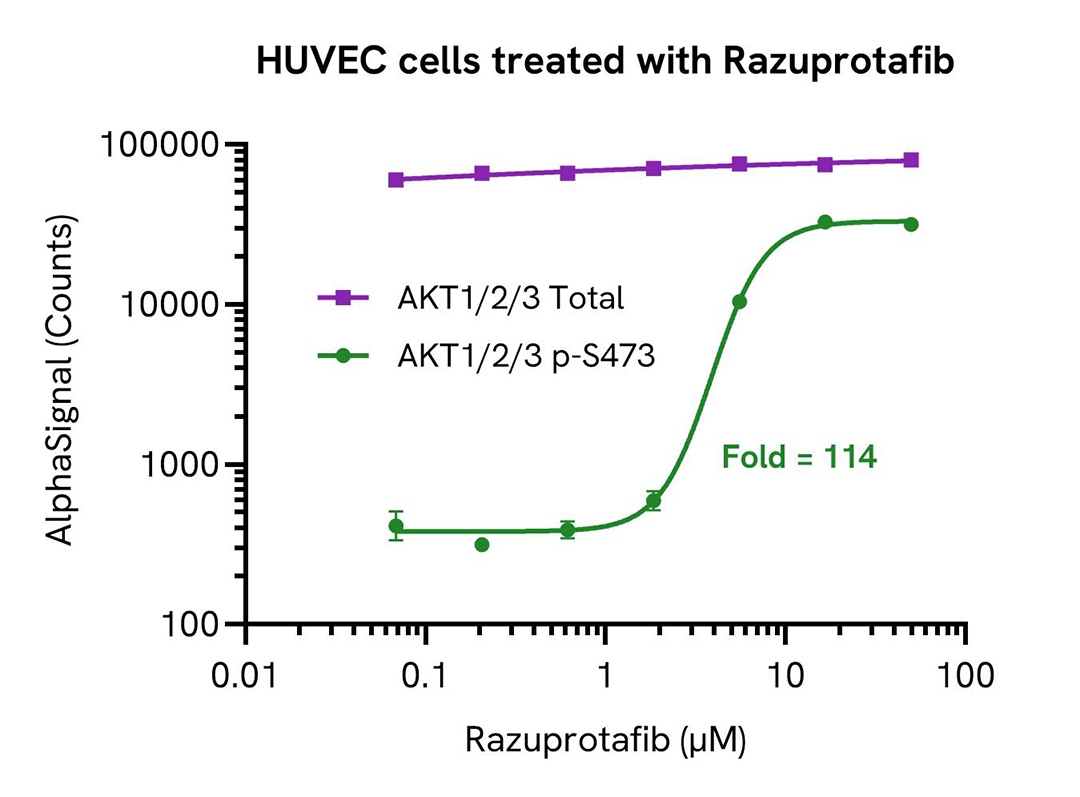
Validation of AKT1/2/3 in Wortmannin treated cells
HEK293 cells were seeded in a 96-well plate (20,000 cells/well) in complete medium, and incubated overnight at 37°C, 5% CO2. The cells were treated with increasing concentrations of Wortmannin for 2 hours.
After treatment, the cells were lysed with 100 µL of Lysis Buffer for 10 minutes at RT with shaking (350 rpm). AKT1/2/3 Phospho (Ser473) and Total levels were evaluated using respective AlphaLISA SureFire Ultra assays. For the detection step, 10 µL of cell lysate (approximately 2,000 cells) was transferred into a 384-well white OptiPlate, followed by 5 µL of Acceptor mix and incubated for 1 hour at RT. Finally, 5 µL of Donor mix was then added to each well and incubated for 1 hour at RT in the dark. The plate was read on an Envision using standard AlphaLISA settings.
As expected, Wortmannin triggered a decrease in the levels of Phospho (Ser473) AKT1/2/3 while Total levels remained unchanged.
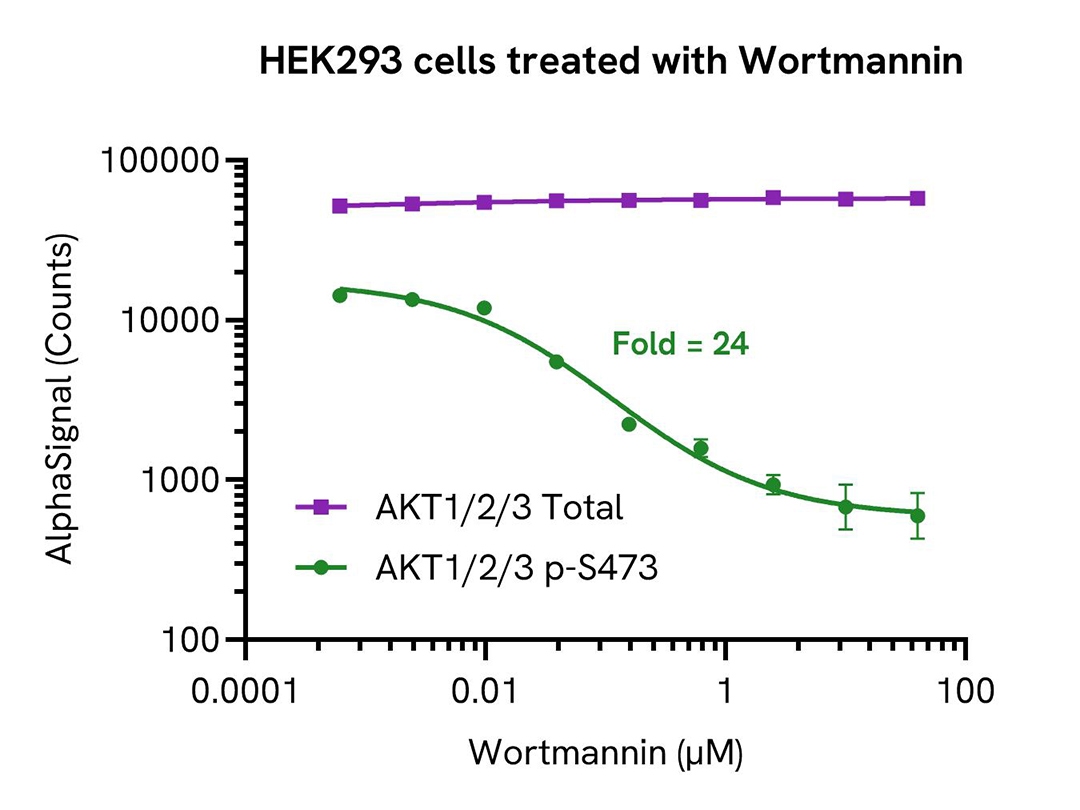
Validation of AKT1/2/3 phospho-(Ser473)/AKT1/2/3 total in Torin1 treated cells
MCF7 cells were seeded in a 96-well plate (40,000 cells/well) in complete medium, and incubated overnight at 37°C, 5% CO2. The cells were treated with increasing concentrations of Torin1 for 18 hours.
After treatment, the cells were lysed with 100 µL of Lysis Buffer for 10 minutes at RT with shaking (350 rpm). AKT1/2/3 Phospho (Ser473) and Total levels were evaluated using respective AlphaLISA SureFire Ultra assays. For the detection step, 10 µL of cell lysate (approximately 4,000 cells) was transferred into a 384-well white OptiPlate, followed by 5 µL of Acceptor mix and incubated for 1 hour at RT. Finally, 5 µL of Donor mix was then added to each well and incubated for 1 hour at RT in the dark. The plate was read on an Envision using standard AlphaLISA settings.
As expected, Torin1 triggered a decrease in level of Phospho (Ser473) AKT1/2/3 while Total AKT1/2/3 levels remained unchanged.
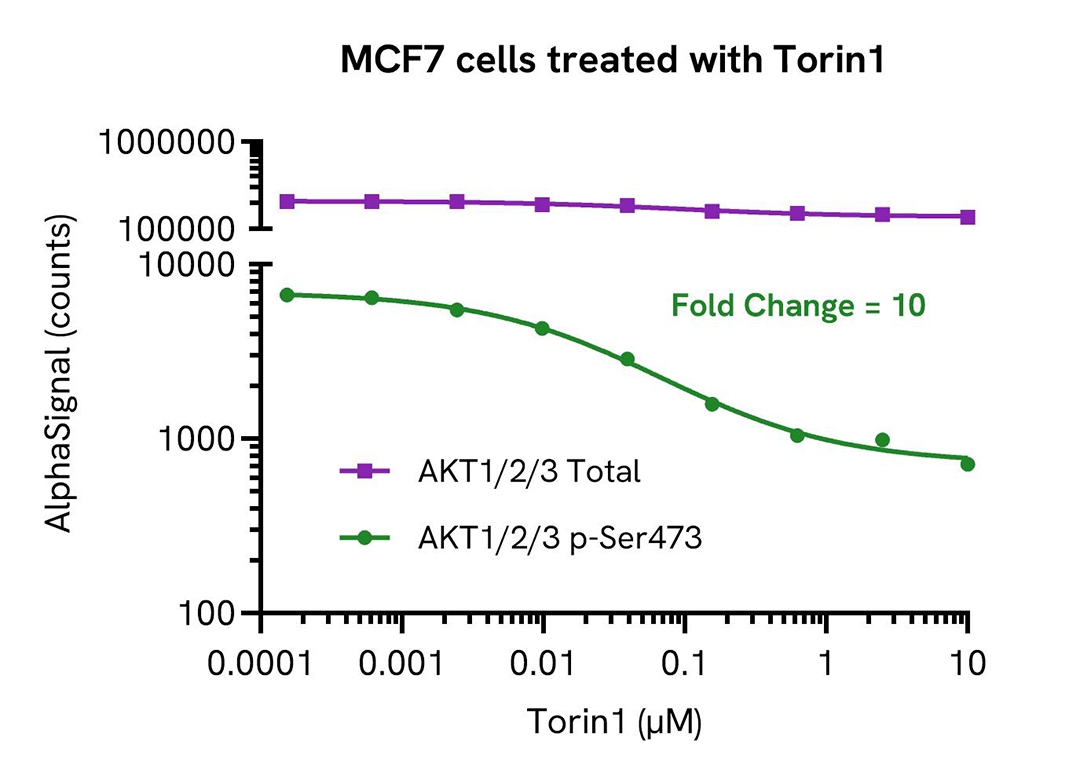
Degradation of AKT1/2/3 total in PROTAC treated cells
PC3 cells were seeded in a 96-well plate (60,000 cells/well) in complete medium, and incubated overnight at 37°C, 5% CO2. The cells were treated with increasing concentrations of AKT PROTAC, MS170 for 24 hours. After treatment, the cells were washed with HBSS and lysed with 100 µL of Lysis Buffer for 10 minutes at RT with shaking (350 rpm). AKT1/2/3 Total and ERK1/2 Total levels were evaluated using respective ALphaLISA SureFire Ultra assays. For the detection step, 10 µL of cell lysate (approximately 6,000 cells) was transferred into a 384-well white OptiPlate, followed by 5 µL of Acceptor mix and incubated for 1 hour at RT. Finally, 5 µL of Donor mix was then added to each well and incubated for 1 hour at RT in the dark. The plate was read on an Envision using standard AlphaLISA settings.
As expected AKT PROTAC MS170 triggered a dose-dependent decrease in the levels of Total AKT1/2/3 while Total ERK1/2 levels remain unchanged.
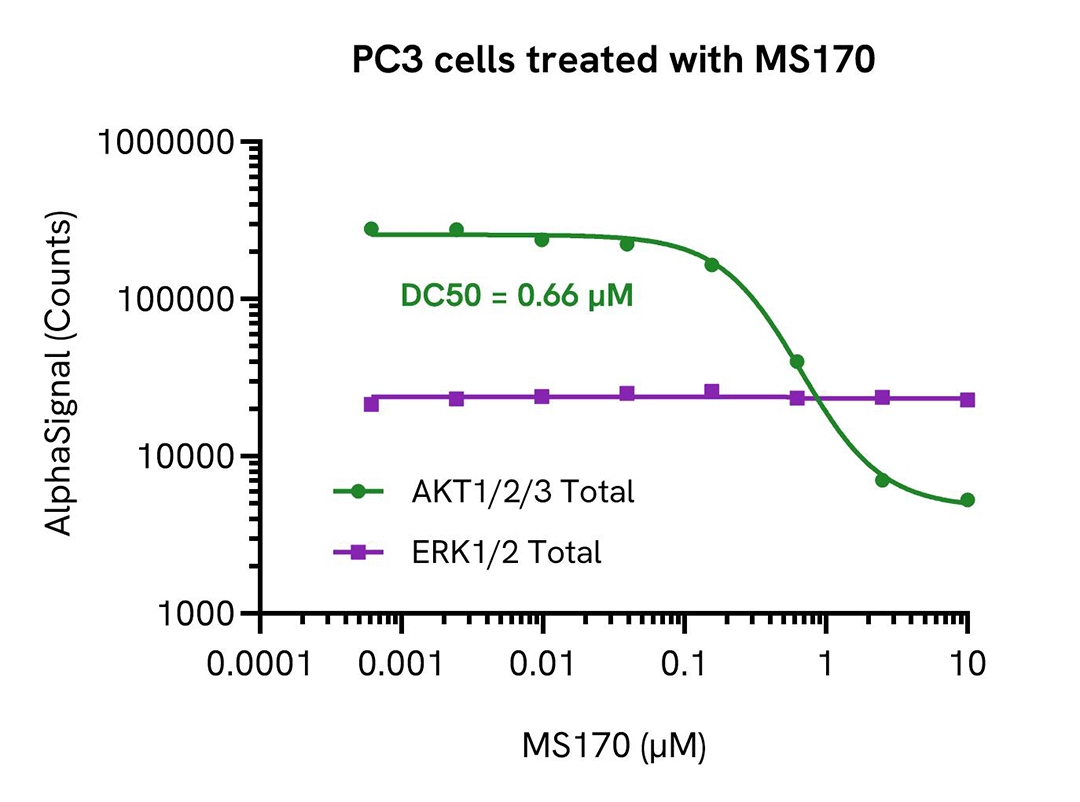
Assay specificity/selectivity
AKT1/2/3 Total assay specificity
Specificity of the AKT1/2/3 Total assay was assessed by using AKT1, 2 and 3 proteins.
Dilutions of recombinant AKT1 (Abcam, ab62279), AKT 2 (Abcam, ab268317) and AKT3 (Abcam, ab60324) were prepared in Lysis Buffer and evaluated using the AlphaLISA SureFire Ultra assay.
For the detection step, 10 µL of diluted protein was transferred into a 384-well white OptiPlate, followed by 5 µL of Acceptor mix and incubated for 1 hour at RT. Finally, 5 µL of Donor mix was then added to each well and incubated for 1 hour at RT in the dark. The plate was read on an Envision using standard AlphaLISA settings.
The AKT1/2/3 Total assay shows reactivity to all three AKT isoforms.
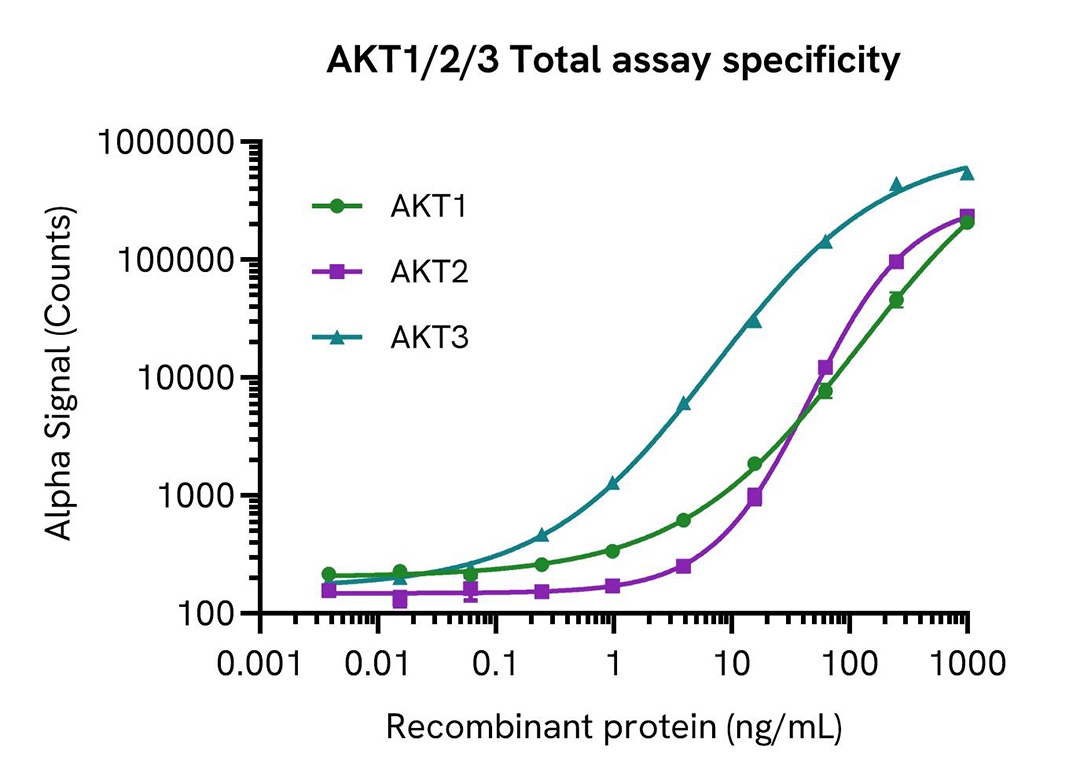
Specifications
| Application |
Cell Signaling
|
|---|---|
| Automation Compatible |
Yes
|
| Brand |
AlphaLISA SureFire Ultra
|
| Detection Modality |
Alpha
|
| Lysis Buffer Compatibility |
Lysis Buffer
|
| Molecular Modification |
Total
|
| Product Group |
Kit
|
| Sample Volume |
10 µL
|
| Shipping Conditions |
Shipped in Blue Ice
|
| Target |
Akt1/2/3
|
| Target Class |
Phosphoproteins
|
| Target Species |
Human
Mouse
|
| Technology |
Alpha
|
| Therapeutic Area |
Cardiovascular
Central Nervous System
Metabolic
|
| Unit Size |
500 assay points
|
Video gallery









Citations
Resources
Are you looking for resources, click on the resource type to explore further.
This guide outlines further possible optimization of cellular and immunoassay parameters to ensure the best possible results are...
The definitive guide for setting up a successful AlphaLISA SureFire Ultra assay
Several biological processes are regulated by...
Discover Alpha SureFire® Ultra™ assays, the no-wash cellular kinase assays leveraging Revvity's exclusive bead-based technology...
Atherosclerosis pathogenesis, cellular actors, and pathways
Atherosclerosis is a common condition in which arteries harden and...
The measurement of protein phosphorylation is a useful tool for measuring the modulation of receptor activation by both antibodies...
This flyer details HTRF™ and AlphaLISA™ assays for investigating key biomarkers and signaling pathways in metabolic disease...


Loading...
How can we help you?
We are here to answer your questions.
